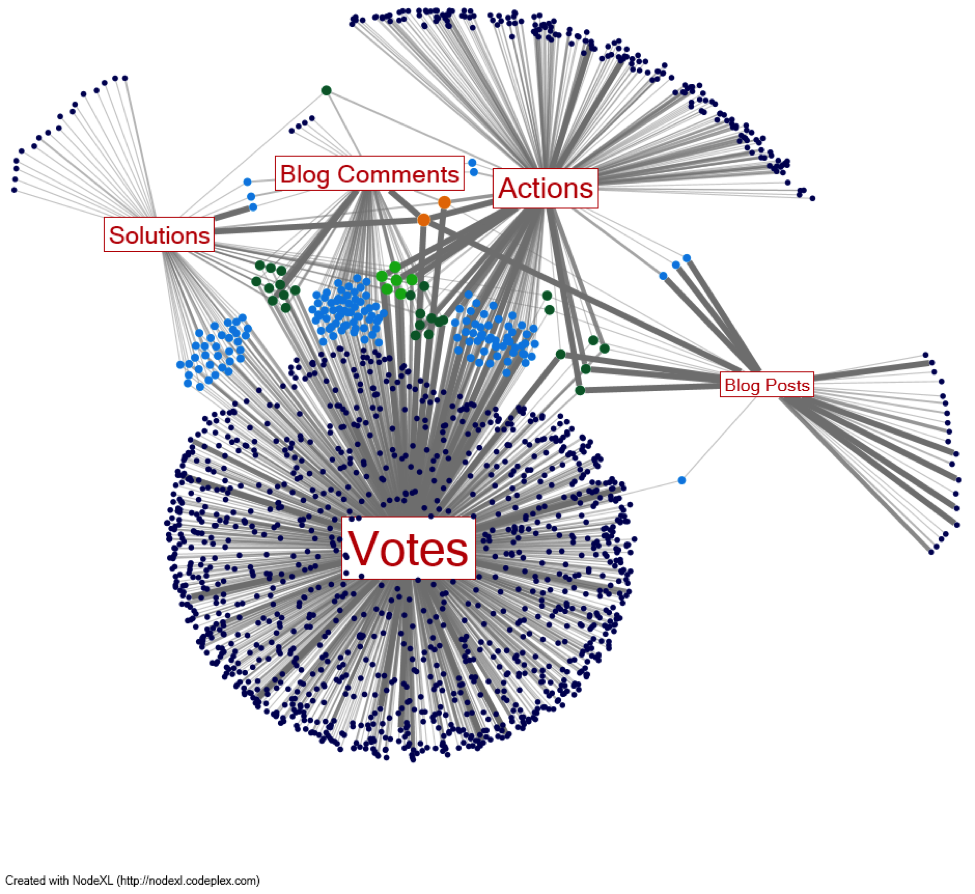Hello there! This is Jes Koepfler, Principal of UXR Consulting in Philadelphia, PA, and a PhD candidate at the University of Maryland in Information Studies, and Derek Hansen, Assistant Professor at Brigham Young University in the Information Technology department and one of the team members behind NodeXL. We are working with some of our colleagues at the Information Policy and Access Center at the University of Maryland to conduct an outcomes-based summative evaluation of an online civic engagement platform called ACTion Alexandria. As part of our multi-year, mixed-methods study, we’re using NodeXL to analyze social network data to address questions about community engagement through site participation.
Lesson Learned: We created the graph below using NodeXL. It shows the 5 key types of participation that visitors can engage in on the ACTion Alexandria website. In this graph, each dot represents a site visitor. Color represents how many activities site visitors have performed (e.g., orange=all 5 activities, dark blue=just 1 activity). Size also indicates the number of activities site visitors have performed. Each line represents an activity the site visitor engaged in on the website. The thickness of the lines (also referred to as edge thickness) shows the number of times a site visitor has performed an activity.
The graph highlights the following things about site participation:
- Most people only perform one activity, although a significant number perform two activities.
- Voting is by far the most popular way that people engage with the site.
- Blog posters post many times, but don’t tend to comment on each other’s blogs.
- People who engage with multiple types of activities are more likely to engage in them multiple times (i.e., have thicker lines).
Hot Tips:
- Bi-modal networks: Social network analysis is commonly used to understand relationships between people, but it can also show interesting patterns of relationships between people and things (like activities on a website). These are called bi-modal networks.
- Network graph aesthetics: Color, labels, line thickness, and size can all be used simultaneously to represent several types of information from your data in a network graph.
- Manual layout: Network graphs are easier to read when as few lines overlap each other possible. In NodeXL, use the manual layout feature to ‘untangle’ any criss-crossing edges or to overlapping nodes.
Rad Resources:
- Chapter 4: Getting Started with NodeXL, Layout, Visual Design, and Labeling of Analyzing Social Media Networks Using NodeXL provides a beginner-level, how-to guide for manipulating network graph aesthetics.
- Check out the NodeXL graph gallery for ideas on ways to use network graph aesthetics to tell different stories with your data.
The American Evaluation Association is celebrating Social Network Analysis Week with our colleagues in the Social Network Analysis Topical Interest Group. The contributions all this week to aea365 come from our SNA TIG members. Do you have questions, concerns, kudos, or content to extend this aea365 contribution? Please add them in the comments section for this post on the aea365 webpage so that we may enrich our community of practice. Would you like to submit an aea365 Tip? Please send a note of interest to aea365@eval.org. aea365 is sponsored by the American Evaluation Association and provides a Tip-a-Day by and for evaluators.


Hi Jes,
Thank you for this posting. I’m curious why you choose to use sna for this data analysis. Was it primarily to explore the visualization?
best regards,
Laura
Hi Laura,
Great question! SNA is just one small piece of study and as you rightly guessed, the purpose in this case was to “see” the patterns of interaction. We are also using web analytics, surveys, interviews, and content analysis to get the full picture of what community engagement looks like on this site.
Best,
Jes